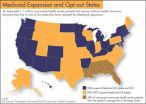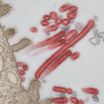(Press-News.org) Despite its name, the Dead Sea does support life, and not just in the sense of helping visitors float in its waters. Algae, bacteria, and fungi make up the limited number of species that can tolerate the extremely salty environment at the lowest point on Earth.
Some organisms thrive in salty environments by lying dormant when salt concentrations are very high. Other organisms need salt to grow. To learn which survival strategy the filamentous fungus Eurotium rubrum uses, a team of researchers led by Eviatar Nevo from the University of Haifa in Israel, Igor Grigoriev of the U.S. Department of Energy Joint Genome Institute (DOE JGI), and Gerhard Rambold, University of Bayreuth, Germany and their colleagues studied its genome. They described their findings in the May 9, 2014 issue of Nature Communications.
"Understanding the long-term adaptation of cells and organisms to high salinity is of great importance in a world with increasing desertification and salinity," the team wrote. "The observed functional and structural adaptations provide new insight into the mechanisms that help organisms to survive under such extreme environmental conditions, but also point to new targets like the biotechnological improvement of salt tolerance in crops." In principle this discovery could revolutionize saline agriculture worldwide by laying the groundwork of understanding necessary to appropriately using salt resistance genes and gene networks in crops to enable them to grow in desert and saline environments.
The DOE JGI team first sequenced, assembled and annotated the 26.2-million base genome of E. rubrum. The team found that the genome contained just over 10,000 predicted genes. They also found that the E. rubrum proteins had higher aspartic and glutamic acid amino acid levels than expected. When the team compared E. rubrum's gene families against those in two other halophilic species (Wallemia ichthyophaga and Hortaea werneckii), they found that high acidic residues were common in all three species, a general trait all salt-tolerant microbes share.
To learn more about the fungus' tolerance for salt, Tami Kis Papo at the University of Haifa grew samples in liquid and solid media at salinities from zero up to 90 percent of Dead Sea water. The researchers found that it had viable spores when grown in 70 percent diluted Dead Sea water, conditions equivalent to an algal bloom in the Dead Sea 20 years ago. A study conducted by Alfons R. Weig at the University of Bayreuth of E. rubrum's transcriptome, that small fraction of the genome that encodes the RNA molecules in order to carry out instructions to build and maintain cells, showed that in high salinity conditions, the fungal cells need to keep cell membrane transport under tight control. "This clearly indicates that the fungus tries to cope 'actively' with its extreme environment and does not simply fall into dormancy," the team noted, "as might be expected by the greatly reduced growth rates."
In addition to contributing to a better understanding of salt tolerance mechanisms for agriculture, this work may also have applicability to the DOE's interests in developing new strategies to improve biofuels production. For instance, the DOE JGI and its partners are sourcing microbial and fungal enzymes for more effective biomass pretreatment with ionic liquids, environmentally benign organic salts often used as green chemistry substitutes for volatile organic solvents.
INFORMATION:
The U.S. Department of Energy Joint Genome Institute, supported by the DOE Office of Science, is committed to advancing genomics in support of DOE missions related to clean energy generation and environmental characterization and cleanup. DOE JGI, headquartered in Walnut Creek, Calif., provides integrated high-throughput sequencing and computational analysis that enable systems-based scientific approaches to these challenges. Follow @doe_jgi on Twitter.
DOE's Office of Science is the largest supporter of basic research in the physical sciences in the United States, and is working to address some of the most pressing challenges of our time. For more information, please visit science.energy.gov.
Salt needed: Tolerance lessons from a dead sea fungus
2014-05-09
ELSE PRESS RELEASES FROM THIS DATE:
States opting out of Medicaid leave 1.1 million community health center patients without health insurance
2014-05-09
WASHINGTON, DC and NEW YORK (May 9, 2014)— An estimated 1.1 million community health center patients are left without the benefits of health coverage simply because they live in one of 24 states that have opted out of the Medicaid expansion, a key part of the Affordable Care Act (ACA), according to a new report.
The research, by the Geiger Gibson/RCHN Community Health Foundation Research Collaborative at Milken Institute School of Public Health (Milken Institute SPH) at the George Washington University also shows that the vast majority (71 percent) of the 1.1 million ...
Implantable device to beat high blood pressure
2014-05-09
An implantable device that reduces blood pressure by sending electrical signals to the brain has been created by a group of researchers in Germany.
The device has successfully reduced the blood pressure in rats by 40 per cent without any major side effects, and could offer hope for a significant proportion of patients worldwide who do not respond to existing medical treatment for the condition.
The first results have been published today, 9 May, in IOP Publishing's Journal of Neural Engineering.
The device consists of 24 individual electrodes that are integrated into ...
Study shows short bursts of intense exercise before meals control blood sugar better than 1 continuous 30 minute session
2014-05-09
New research published in Diabetologia (the journal of the European Association for the Study of Diabetes) indicates that brief bursts of intense exercise before meals (termed exercise 'snacking' by the study authors) helps control blood sugar in people with insulin resistance more effectively than one daily 30-minute session of moderate exercise. The research was conducted by exercise science and medicine researchers, including Monique Francois and Associate Professor James Cotter from the University of Otago, Dunedin, New Zealand.
The study used a cross-over design, ...
From age 30 onwards, inactivity has greatest impact on women's lifetime heart disease risk
2014-05-09
From the age of 30 onwards, physical inactivity exerts a greater impact on a woman's lifetime risk of developing heart disease than the other well-known risk factors, suggests research published online in the British Journal of Sports Medicine.
This includes overweight, the finding show, prompting the researchers to suggest that greater effort needs to be made to promote exercise.
The researchers wanted to quantify the changing contribution made to a woman's likelihood of developing heart disease across her lifetime for each of the known top four risk factors in Australia: ...
Frequent arguments with family and friends linked to doubling in death risk in middle age
2014-05-09
Frequent arguments with partners, relatives, or neighbours may boost the risk of death from any cause in middle age, suggests research published online in the Journal of Epidemiology & Community Health.
Men and those not in work seemed to be the most vulnerable, the findings indicate.
The evidence suggests that supportive social networks and strong relationships are good for general health and wellbeing, but the authors wanted to find out if the stressors inherent in family relationships and friendships had any impact on the risk of death from any cause.
They therefore ...
Hurricanes Katrina and Rita may have caused up to half of recorded stillbirths in worst hit areas
2014-05-09
Hurricanes Katrina and Rita may have been responsible for up to half of all recorded stillbirths in the worst hit areas, suggests research published online in the Journal of Epidemiology & Community Health.
And the true fetal death toll may even be higher, because of the displacement of people whose homes and way of life were destroyed, suggest the authors.
Hurricane Katrina struck the state of Louisiana, USA, on August 29 2005, followed by Hurricane Rita a month later on September 24. Katrina was the costliest natural disaster in American history, while Rita was the ...
Super-charged tropical trees of Borneo vitally important for global carbon cycling
2014-05-09
A team of scientists has found that the woody growth of forests in north Borneo is half as great again as in the most productive forests of north-west Amazonia, an average difference of 3.2 tons of wood per hectare per year.
The new study, published today in the Journal of Ecology, examined differences in above-ground wood production (one component of the total uptake of carbon by plants) which is critically important in the global cycling of carbon.
Trees are taller for a given diameter in Southeast Asia compared with South America, meaning they gain more biomass ...
Exact outline of melanoma could lead to new diagnostic tools, therapies
2014-05-09
CORVALLIS, Ore. – Researchers at Oregon State University have identified a specific biochemical process that can cause normal and healthy skin cells to transform into cancerous melanoma cells, which should help predict melanoma vulnerability and could also lead to future therapies.
More than 70,000 cases of melanoma, the deadliest form of skin cancer, develop in the U.S. every year.
The work was published today in PLoS Genetics, in work supported by the National Institutes of Health.
"We believe this is a breakthrough in understanding exactly what leads to cancer ...
IL-27 balances the immune response to influenza and reduces lung damage
2014-05-09
Highly pathogenic (dangerous) influenza strains elicit a strong immune response which can lead to uncontrolled inflammation in the lung and potentially fatal lung injury. A study published on May 8th in PLOS Pathogens demonstrates the importance of IL-27 for the control of immunopathology—damage to the lung tissue caused by the immune system—and the therapeutic potential of well-timed IL-27 application to treat life-threatening inflammation during lung infection.
Alf Hamann, from Deutsches Rheuma-Forschungszentrum and Charité Universitätsmedizin Berlin, Germany, and colleagues, ...
SOCS4 prevents a cytokine storm and helps to clear influenza virus from the lung
2014-05-09
Certain influenza strains are highly virulent—they cause more serious disease and kill more people. Some of the damage is caused by the stronger immune response such strains elicit, especially in the lung. A study published on May 8th in PLOS Pathogens identifies SOCS4 as a key regulator of the immune response against influenza virus.
Lukasz Kedzierski, Sandra Nicholson, and colleagues from the Walter and Eliza Hall Institute of Medical Research and the University of Melbourne, Australia, studied mice with a mutation in the Socs4 gene, a member of a gene family whose ...



